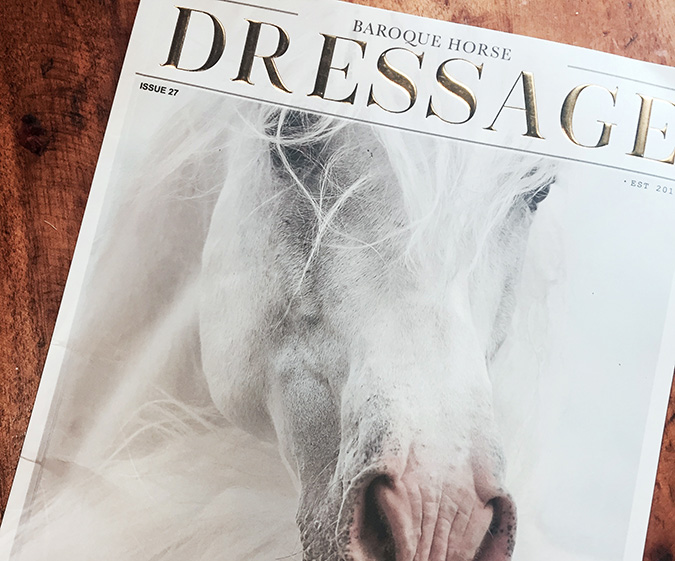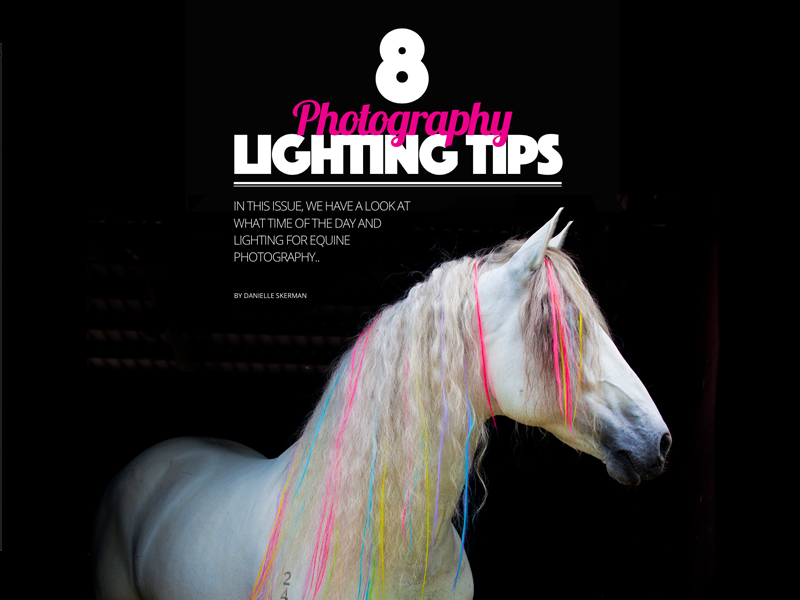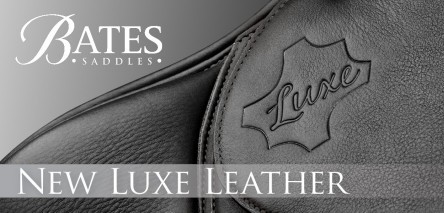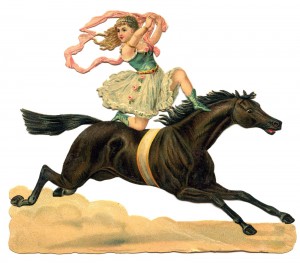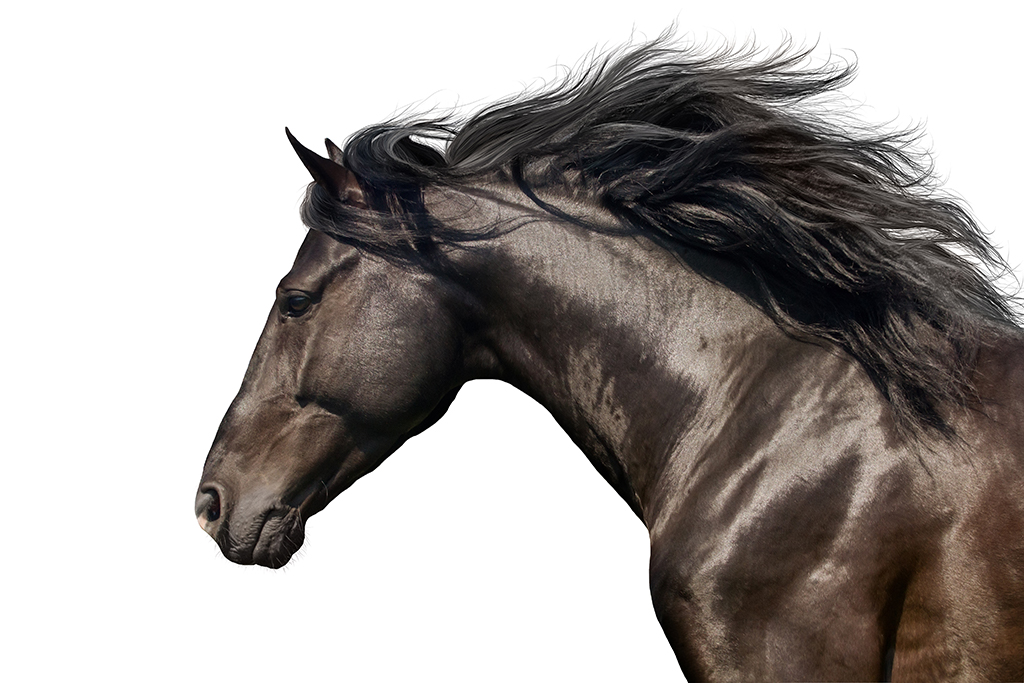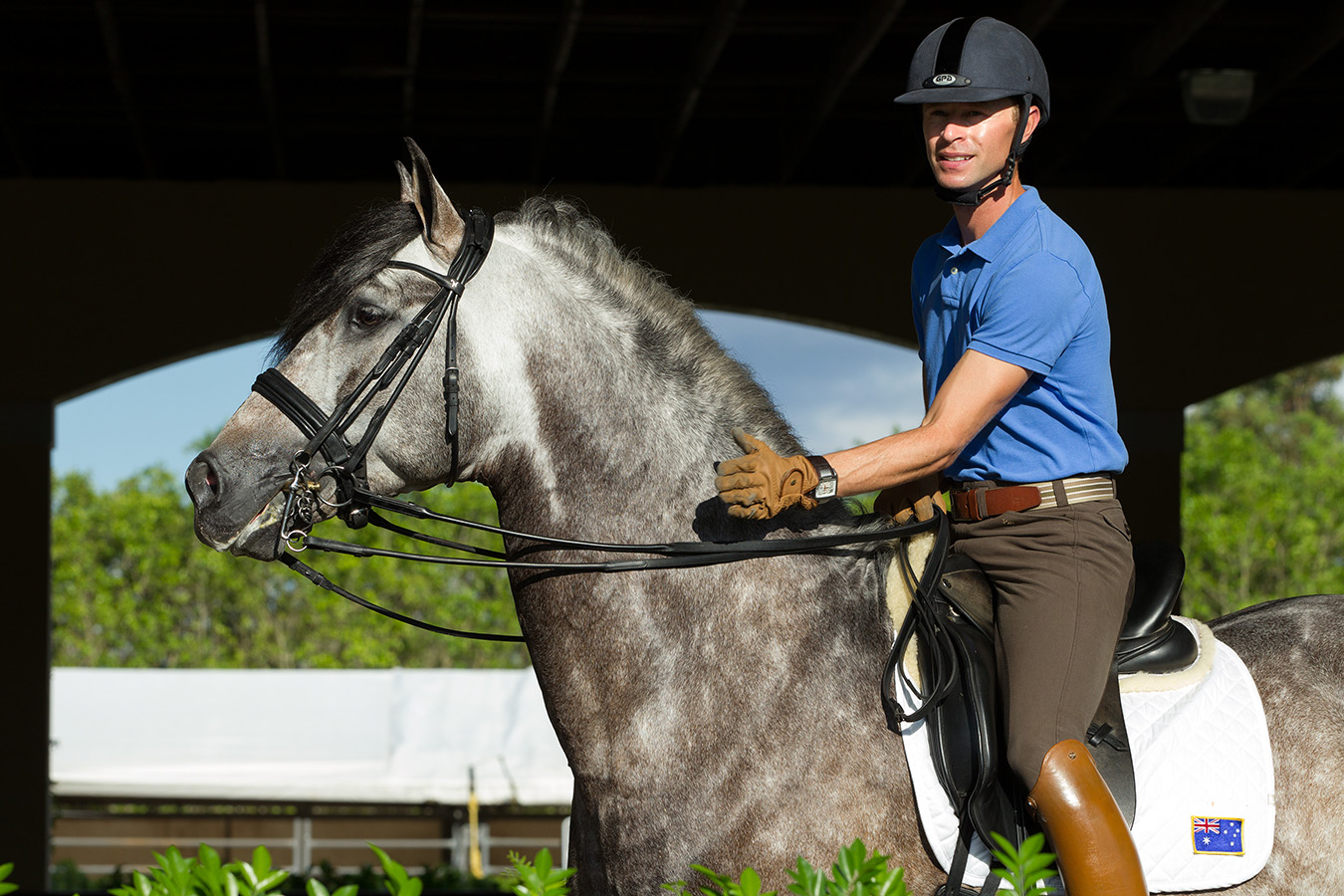
Nicholas Fyffe Chasing THE DREAM
Interview: Danielle Skerman | Photos: Debra Jamroz
As printed in Issue 16 2014

With big hopes and dreams in December 2010, Nicholas Fyffe, a 28-year-old Aussie, took the big leap to move to Wellington, Florida, in the United States. This was after two years of training in Germany under top international riders, which included Martina Hannover Sternberg, Ulla Salzgeber, Hubertus Schmidt, and Catherine Haddad. There in the USA, the young, talented, and eager Aussie fell in love with the Iberian horse.
Nicholas grew up in a small country town in New South Wales (Australia) called Finley. There, he had an equine-loving family with both his mother and grandfather being successful racehorse trainers. Naturally, Nicholas got an early start riding at a tender three years of age with his first horse, a Shetland pony all of 8.5 hands high. His love for horses continues to this day.
Nicholas started his equine career as a keen eventer competing internationally at three-day eventing. In 2003, after spending a year training in Germany with Martina Hannover, competing at the international dressage shows, and the whole experience of the World Equestrian Games in Jerez, Nicholas made the decision to focus solely on pure dressage. “That year, I had a series of falls whilst eventing as well as my horses undergoing some injuries, so my love for the sport wasn’t as strong. Watching top-class combinations like Ulla Salzgeber and Rusty, Beatriz Ferrer Salat and Beavalais, and Nadine Capellman and Farbenfroh, completely inspired me. It was there and then that I redirected my goals.”
In 2010 Nicholas relocated to Wellington, Florida and for over a year was the assistant trainer to top international rider Oded Shimoni, based at StillpointFarm. Nicholas is also the rider and trainer of the talented PRE stallion, Fiero HGF, originally owned in full by Robert Dover. Nicholas now splits his time between Canada and Florida working with his partner, Canadian Olympian David Marcus. Since his arrival to the North America, Nicholas has shown all levels from three-year-old stallion classes all the way through International Grand Prix. He is currently listed on the Australian National Dressage Elite Squad, A Squad and Futures squad with three different horses.
Baroque Horse magazine editor Danielle Skerman spoke to Nicholas about what he’s been up to and what’s on the cards for his future.
BH: How and when did you get your first ride on a PRE?
NF: In 2011 I was working as Oded Shimoni’s assistant, where we were based at Stillpoint Farm. Robert Dover is also based at this stable where he kept his then-rising three-year-old colt, Fiero HGF. Robert knew that I had started many horses in Australia and Germany and asked me to start Fiero under saddle. I had a great connection with Fiero from very early on. We were a great fit and Robert was happy, so I’ve ridden him ever since!
BH: Have you ridden, or do you ride any other baroque breeds? (Friesian, Lusitano etc.)
NF: Many years ago, I was riding with Martina Hanover Sternberg in northern Germany. She was training many riders from Portugal at the time and there were quite a few Lusitano stallions there that I rode.

BH: What is it about the PRE’s that you like the best?
NF: There are many qualities that I find so appealing about the PRE. They are certainly very intelligent and I find very intuitive horses. They can be very sensitive, which I find a huge plus—but to be really honest, my favourite quality is that they are so comfortable to ride. I always say that I could ride ten Spanish horses with the energy that it takes to ride one big Warmblood. It is not physically hard work to ride them, and they are generally so nice and smooth to sit on. my lower back certainly appreciates this.
BH: You once did three-day eventing. What was it that drew you into dressage on its own?
NF: I always found dressage interesting despite being initially focused on eventing. In 2002 I was a working student for an international rider who rode both disciplines at the highest level. He made the Australian Dressage team for the World Equestrian Games held in Jerez, Spain. Prior to this we were based at The Rehbeins’, Groenwohldhof in Germany. Here I witnessed dressage sport at the highest level and was fascinated and inspired. The actual WEG in Jerez was a phenomenal event to be involved with, too. Here I saw many beautiful Spanish horses perform, but never in my mind really thought that I would one day be riding them in international dressage competition.
BH: You have three PREs in your barn at the moment amongst your Warmbloods. How do you find transitioning your riding between the different types? Do you find you have to ride the PREs differently?
NF: Honestly, no. To me they are dressage horses being trained for top sport regardless if they are Oldenburg, Hanoverian or Spanish. Every horse has his or her own weakness and strengths. my job as a trainer is to improve the weak areas and develop their strengths. I try to ride and train in a very systematic and clear way that should translate to all breeds. The goal is sound, strong, motivated and happy horses for top sport. I find that I start the Spanish horses exactly the same way that I would start a Warmblood horse. Like all dressage horses, each is unique but the general system is the same. Sometimes the young Spanish horses initially develop a little faster under saddle, as they are quite compact and strong compared to the bigger Warmbloods that are still finding their balance.

BH: They say the Iberian breeds are best at collection; however, they lack in extension. Have you found this to be true, and if so how do you combat it?
NF: I certainly agree that the Spanish horses that I have been fortunate to train are very strong in collection. I also have to say that Fiero HGF has a great extended trot by nature. He was purposely bred as a dressage horse. His sire Grandioso
is a top international dressage horse. I am fortunate that my Spanish horses are all bred by informed and educated breeders that breed for dressage. A dressage horse must be able to both collect and extend. The breeders see this, and I feel the horses seem to be going in the right directions for international dressage.
BH: So would you say that saying is less relevant nowadays with the well/purpose bred Iberian horses?
NF: I feel that a well-bred horse is a well-bred horse whether it be Iberian or not. I still firmly believe when you are searching for a top dressage horse, if you source a horse that was bred and produced exactly for dressage, you will likely increase your odds for success. Of course, I know many variables and exceptions to the rule. I know of a wonderful bullfighting-bred stallion out of Brazil that is proving himself as a nice dressage horse. And of course, many jumping horses turned dressage. However, you need to take all of the factors that a dressage horse requires into consideration and weigh them. On top of this to me, the most important detail, regardless of anything else, is simple. It’s the partnership and connection between the horse and rider. It works, or it doesn’t. If it is particularly strong, some weaknesses may be more easily overcome.
BH: Being in the serious side of the dressage world, how do you now find the reception is to competing on a Spanish horse?
NF: Every single international judge at a CDI has been very fair and encouraging in the scores for my Spanish horses. I have never experienced anything negative or discouraging
towards competing on a Spanish horse. Occasionally, but not often, at national shows, I have received scores that I felt were less than fair whilst on Spanish horses. However, to be perfectly honest, I have this issue with Warmbloods too and I can put it down to lack of education of the judges. I am confident that when I show a great Spanish horse on the international stage, that I will receive the scores that are deserved. These judges are incredibly well educated, heavily scrutinised, and they have to answer for their actions. To them, 80 percent is 80 percent, whether it’s Fuego or Valegro.
BH: You are a proud Aussie and still have many Aussie connections here. Do you think you’ll ever come back to compete on Aussie soil?
NF: I would love to. I always see myself back there eventually. It’s my home and I am very proud of my country. It’s just so far from everywhere else. For me, to make it to the top of my game doesn’t fit in with living in Australia right now. It’s four years since I competed on home soil. I really have no idea when the next time will be, but I hope it will happen eventually. As much as I miss Australia, my life is settled here now. It took time, but I have a wonderful support network around me. I am fortunate to be a part the Shantal Rox Syndicate that secured such a top quality horse for me.
I also work closely with Debbie Witty of Trilogy Saddles and my horses have never felt so comfortable. Mette Larson of Metlar Saddlery and Neu Schule Bits of USA and Canada has outfitted all of my horses in the state of the art bits too. It takes time for a team to develop around you. I am so fortunate and appreciative. It would be very hard to start over again.

BH: Do you have a favourite horse in your stables? If so, who and why?
NF: I have no favourites, but I really do have a great connection with Fiero HGF. He’s six now and a boy genius. I’ve been riding him for three years, and we know each other very well. As a professional rider, I know that, sadly, horses come and go, and Fiero is my longest partner since arriving in the USA. That relationship that only develops with time is very special, and I look forward to riding him every day. He is so intelligent and talented. The movements are so easy for him. Now it‘s just a case of passing the time and keeping him happy. He understands just about everything from the Grand Prix, so my job is to wait until he’s strong and ready. It’s a luxury position to be in.
BH: What do you think are the strengths and weaknesses of the Iberian horse?
NF: The strengths of the Iberian horses are that they usually have enough talent to reach the highest level in dressage, yet they have a character that is still suitable for an amateur rider. This is a difficult combination to find.

BH: No great weakness that you can really see?
NF: Well, I don’t see many Iberian horses with careers like Damon Hill. In saying this, I mean horses walking for 10, winning at the World Championships for young horses and then having successful international Grand Prix careers. I certainly believe that the Spanish and Lusitano horses thrive at the upper levels when they are more mature and able to show the fruits of their strength in collection. I use the young horses’ classes as a good experience and to set my horses up for the upper levels. The World Young Horse Championships are not my personal Olympics. The Olympics are, and there you ride the Grand Prix test, and that is what I train for. I have a strong conviction that these horses, in the right hands, will continue to reach the top of the sport. They will never replace the Warmblood, but why should they? It makes dressage so much more interesting. Like in the days of Anky V’s Isabell. Their horses and riding styles were completely different in so many ways, but they were neck and neck on the scoreboard. I am lucky that I started riding dressage at the time that I did. The Spanish Team medalling at the WEG in 2002, horses like Invasor, Fuego and Grandioso are already paving the way. Australia selected Lusitano on the dressage team at the 2008 Olympics, and I was listed on the elite squad last year on a PRE…The good horses get good scores, so I feel very confident to prepare Faisan AT and Fiero HGF for the international levels.
BH: What is your future plan for you and competition dressage?
NF: Currently I plan to continue to divide my time between Wellington, Florida and Campbellville, Ontario, Canada with my partner, David Marcus. I have two horses that I think are very exciting for my future that I own or part own. Fiero HGF and a ten-year-old Oldenburg mare, Shantal Rox. Shantal is just about ready for her first international Grand Prix, and Fiero has been performing strongly in the FEI six-year-old tests. I don’t show him often because he is so well behaved on the shows and although only six, behaves like quite a seasoned competitor. Next year, he can start to show internationally at the small tour, and then my job is to listen to him and he will tell me when he is ready to do the Grand Prix. I certainly would like to represent Australia at a major championship, but for me, the journey there has to be enjoyable too. We all know things can go wrong with horses at the last minute, so I try hard to make sure that I‘m still loving the day to day. David is certainly looking for selection on the Canadian team at the World Championships this year and I look forward to supporting him through that. I’m in a fortunate position that the support runs both ways. We have similar riding styles and keep each other’s horses going when each other is away. Daily, we both have eyes on the ground for each other and understand each other’s stresses. I love the Canadian summers and Wellington winters. What more could I want?
Here at BHM, we would like to thank Nicholas for taking the time to talk to us. We thoroughly enjoyed it and look forward to an exciting future for Nicholas.
http://www.marcusfyffedressage.com/
https://www.facebook.com/MarcusFyffeDressage/
© Barqoue Horse Pty ltd

